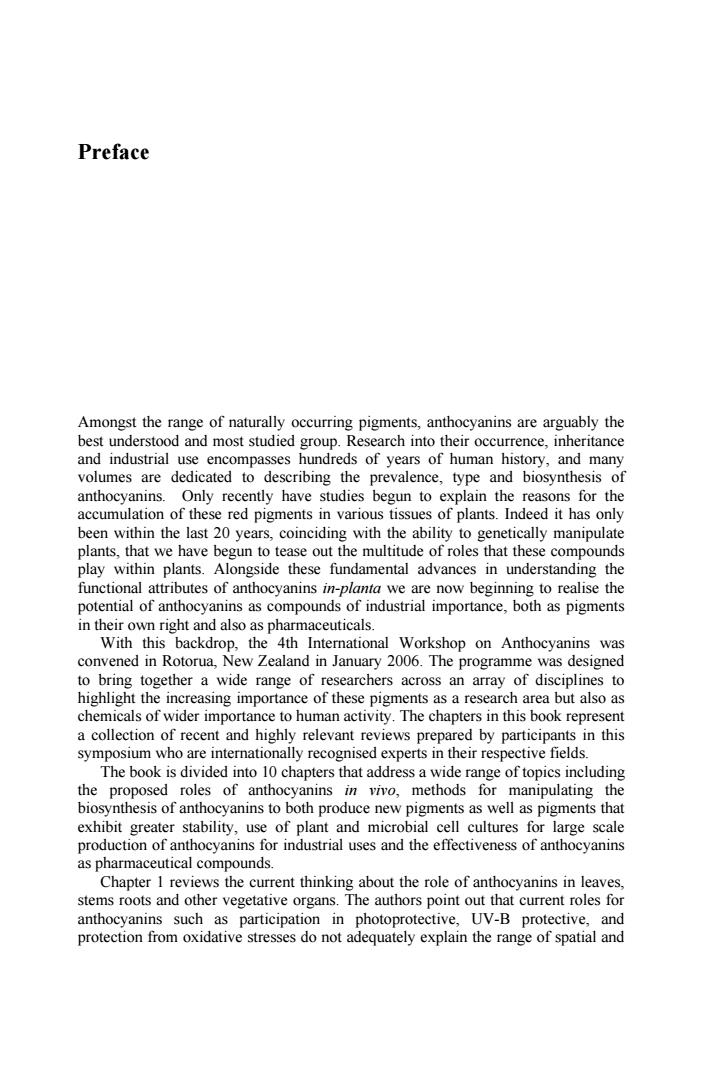正在加载图片...

Preface at the range of natrly occurring Pigments anihoeyanins sare arguably the nd mo st stu ed grou into the edicated ribin stu of variou r pla L e last 20 y play in fun I advan f attributes of anthocyanins n-planta we are now beginn g to realise the potential I of anthocyanins as compounds of industrial importance,both as pigments in their own right and also as pharmaceuticals. With this backdrop,the 4th International Workshop on Anthocyanins was convened in Rotorua,New Zealand in January 2006.The programme was designed to bring together a wide range of researchers across an array of disciplines to highlight the increasing importance of these pigments as a research area but also as chemicals of wider importance to human activity.The chapters in this book represent a collection of recent and highly relevant reviews prepared by participants in this symposium who are internationally recognised experts in their respective fields The book is divided into 10 chapters that address a wide range of topics including the proposed roles of anthocyanins in vivo,methods for manipulating the biosynthesis of anthocyanins to both produce new pigments as well as pigments that exhibit greater stability,use of plant and microbial cell cultures for large scale production of anthocyanins for industrial uses and the effectiveness of anthocyanins as pharmaceutical compounds. Chapter I reviews the current thinking about the role of anthocyanins in leaves stems roots and other vegetative organs.The authors point out that current roles for anthocyanins such as participation in photoprotective.UV-B protective.and protection from oxidative stresses do not adequately explain the range of spatial and Preface Amongst the range of naturally occurring pigments, anthocyanins are arguably the best understood and most studied group. Research into their occurrence, inheritance and industrial use encompasses hundreds of years of human history, and many volumes are dedicated to describing the prevalence, type and biosynthesis of anthocyanins. Only recently have studies begun to explain the reasons for the accumulation of these red pigments in various tissues of plants. Indeed it has only been within the last 20 years, coinciding with the ability to genetically manipulate plants, that we have begun to tease out the multitude of roles that these compounds play within plants. Alongside these fundamental advances in understanding the functional attributes of anthocyanins in-planta we are now beginning to realise the potential of anthocyanins as compounds of industrial importance, both as pigments in their own right and also as pharmaceuticals. With this backdrop, the 4th International Workshop on Anthocyanins was convened in Rotorua, New Zealand in January 2006. The programme was designed to bring together a wide range of researchers across an array of disciplines to highlight the increasing importance of these pigments as a research area but also as chemicals of wider importance to human activity. The chapters in this book represent a collection of recent and highly relevant reviews prepared by participants in this symposium who are internationally recognised experts in their respective fields. The book is divided into 10 chapters that address a wide range of topics including the proposed roles of anthocyanins in vivo, methods for manipulating the biosynthesis of anthocyanins to both produce new pigments as well as pigments that exhibit greater stability, use of plant and microbial cell cultures for large scale production of anthocyanins for industrial uses and the effectiveness of anthocyanins as pharmaceutical compounds. Chapter 1 reviews the current thinking about the role of anthocyanins in leaves, stems roots and other vegetative organs. The authors point out that current roles for anthocyanins such as participation in photoprotective, UV-B protective, and protection from oxidative stresses do not adequately explain the range of spatial and